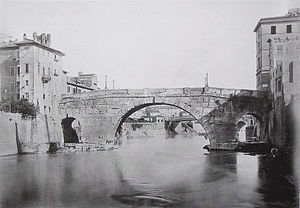Ponte Cestio
Coordinates: 41 ° 53 ′ 24 " N , 12 ° 28 ′ 38" E
| Ponte Cestio (Ponte San Bartolomeo) (Pons Cestius) |
||
|---|---|---|
| Convicted | Connection between Tiber Island and Trastevere | |
| Crossing of | Tiber | |
| place | Rome ( Italy ) | |
| construction | Arch bridge with vaulted vaults | |
| overall length | 54.30 m | |
| Number of openings | 3 | |
| Clear width | 3 × 25.40 m | |
| construction time | Between 60 and 40 BC Chr. | |
| location | ||
|
|
||
| The Roman bridge around 1880, before the Tiber was widened | ||
The Ponte Cestio , also Ponte San Bartolomeo ( Latin Pons Cestius ) is a bridge over the Tiber in Rome ( Rione XII ). As a counterpart to the Ponte dei Quattro Capi, it connects the Tiber Island with the Trastevere district .
It was made between 60 and 40 BC. BC probably built by Lucius Cestius, the brother of Gaius Cestius Epulo , who is known for his tomb, the Cestius pyramid . It was renovated several times: in 152 under Emperor Antoninus Pius , in 370 by Valentinian I , Valens and Gratian . In the following years it was called Pons Gratiani (Gratiansbrücke). A plaque on the parapet commemorates another restoration in 1193.
Since the 15th century, the bridge has been called Ponte San Bartolomeo after the church of San Bartolomeo all'Isola on the Tiber Island . In the course of the canalization of the Tiber, between 1888 and 1892, the two outer arches of antiquity were replaced by openings of a larger span, partly using material from the neighboring theater of Marcellus ; the central arch is still made of old material.
The bridge is open to vehicle and pedestrian traffic.
Individual evidence
- ^ Romolo A. Staccioli, Guida di Roma antica . Milano 1994 p. 441


